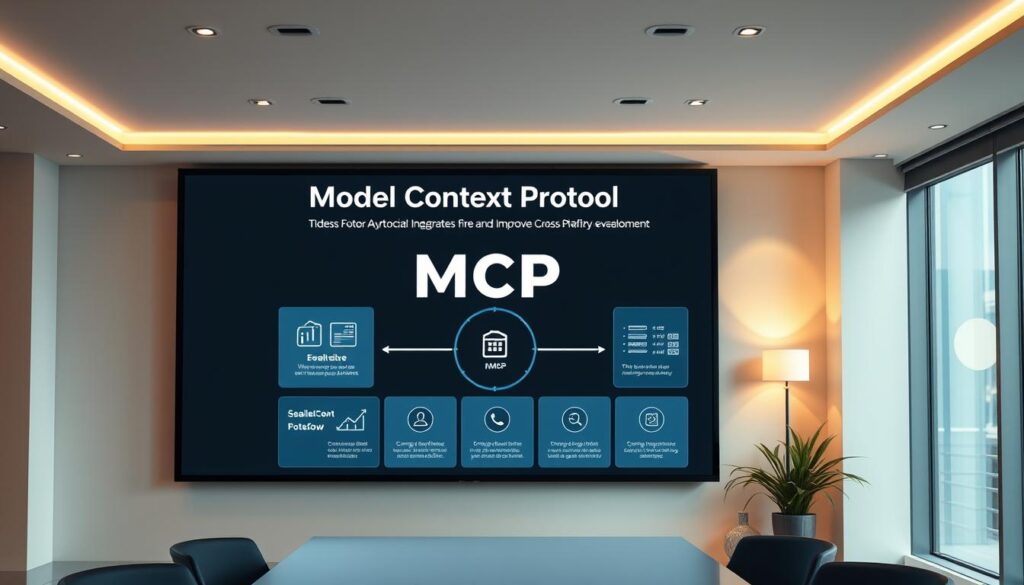Imagine building an app that needs to connect AI models, databases, and third-party tools. You’re juggling code for each integration, debugging conflicting APIs, and losing hours to repetitive work. That’s where MCP steps in.
Developed by Anthropic, the Model Context Protocol (MCP) is like a universal adapter for AI systems. It turns chaos into clarity, letting developers link tools, data, and models through one streamlined framework. Whether you’re scaling a startup or overhauling enterprise software, MCP cuts through complexity.
Think of it as the USB-C of AI integration. Just as USB-C standardized charging, MCP unites diverse systems under a single language. No more rewriting code for every new tool. No more fragmented workflows. Just faster, smarter development.
Key Takeaways
- MCP simplifies AI integration with a unified standard for tools and data sources.
- It boosts performance by letting AI models access real-time data directly during interactions.
- Developers save time switching between LLMs without rebuilding entire systems.
- Security stays strong with user-controlled access and isolated interactions.
- Stateful sessions let AI remember context across conversations, improving user experiences.
Introduction to the Model Context Protocol
The Model Context Protocol (MCP) is changing how AI systems use data. It acts as a universal connector, fixing issues like knowledge gaps in large language models (LLMs) and broken integrations. MCP makes it easier for developers to create smarter apps by standardizing how AI tools talk to data sources.
For instance, tools like Claude Desktop use MCP to easily access data in real-time. This is done without needing to write custom code.
Defining the Model Context Protocol
MCP works with a client-host-server setup, using JSON-RPC 2.0 for safe, structured talks. It has three main parts:
- Prompts for structured messaging
- Resources for context data storage
- Tools for executable functions
It focuses on security with OAuth-based login and user consent controls. This keeps data exchanges private. Servers can run locally or remotely, supporting any programming language via standard HTTP or stream protocols.
Why It Matters for Developers
MCP cuts down development time by up to 50% by removing the need for custom API integrations. It offers features like two-way context and real-time updates. This lets developers build AI systems that can change with data.
The mcp certification program shows who knows how to use MCP well. This makes it a valuable skill in tech jobs. By learning MCP, developers can use a wide range of pre-built connectors and top-notch security tools. This boosts efficiency and innovation in AI projects.
“MCP transforms how AI interacts with data—making complex integrations simple and secure.”
The Evolution and History of MCP
Understanding MCP’s evolution is key for developers, especially when getting ready for the mcp exam. It shows how MCP has grown from its start to becoming a key standard in AI. This journey shows its increasing role in AI integration.
“MCP is designed to streamline AI integration with external data sources, ensuring secure and efficient communication.”
Early Developments in MCP
In 2024, Anthropic introduced MCP to solve AI integration problems. The early versions aimed to:
- Standardize JSON-RPC 2.0 communication
- Define basic parts (Host, Client, Server)
- Focus on security with TLS encryption
Modern Advances and Transformations
Recent updates have made MCP even better:
| Component | Function |
|---|---|
| MCP Host | Manages AI model interactions |
| MCP Client | Requests data from outside systems |
| MCP Server | Offers structured data responses |
Now, MCP supports HTTP/Server-Sent Events. Future plans include TypeScript/Python SDKs and OAuth 2.0 authentication. These updates match the mcp exam curriculum, which covers both old and new features.
MCP has come a long way from being an experimental tool to a key standard. Developers studying for the mcp exam need to know this history. It helps them understand MCP’s evolution and its uses in business systems and AI tools.
Understanding the Technical Foundations
MCP has evolved, and mastering its technical core is key. This section explains the architecture and mechanisms. It shows how developers use the protocol effectively.
Key Concepts and Terminology
| Component | Function | Example |
|---|---|---|
| Context Tokenization Engine (CTE) | Optimizes input into token representations | Adaptive compression for text streams |
| Semantic Graph Database (SGD) | Manages entity relationships | Weighted connections for contextual relevance |
| State Transition Controller (STC) | Manages conversation flow | Finite state machines for topic shifts |
Core Protocol Mechanisms
- Client-server model using JSON-RPC 2.0
- Two transport options: stdio (local) and HTTP/SSE (remote)
- Three core capabilities: Resources, Tools, and Prompts
In mcp training, developers learn how servers work with data sources. They use standardized interfaces. The handshake ensures clients and servers work together well.
This design makes it easy to add new features. It keeps systems running smoothly and efficiently.
“MCP’s layered architecture empowers teams to build context-aware applications without sacrificing performance,” says the protocol’s technical whitepaper.
Knowing these mechanisms is crucial for mcp training. Each part, from memory management to inference optimization, helps keep interactions meaningful.
Practical MCP Implementation Strategies
Mastering MCP implementation boosts productivity and opens doors to high-demand roles where mcp salary premiums are common. Start with these actionable steps to deploy MCP effectively:
- Install Node.js 18+ and initialize a project with
npm init -y. - Run
npm install @modelcontextprotocol/sdk typescript zodto add dependencies. - Create a
tsconfig.jsonwith paths for TypeScript modules. - Set environment variables using Azure OpenAI credentials and deployment names.
- Build error-handling functions to log API call failures and retries.
- Use Chainlit to design a user interface for real-time model interaction.
| Variable | Purpose |
|---|---|
| AZURE_OPENAI_ENDPOINT | API endpoint URL from Azure dashboard |
| AZURE_API_KEY | Authentication key for API requests |
| MODEL_DEPLOYMENT | Specific model identifier in Azure resources |
Recursion functions handle sequential tool calls, while conversation history tracking maintains context. Proper setup reduces downtime and improves API response efficiency. Developers who optimize these workflows position themselves for roles where mcp salary growth aligns with technical proficiency. Testing tools like Postman validate API integrations before full deployment.
Successful MCP deployments require balancing speed and security. Monitoring tools like Azure Monitor track performance metrics critical for scaling. Teams adopting these strategies reduce operational costs—key for employers valuing MCP expertise. This directly impacts mcp salary potential in competitive markets.
Integrating MCP with Existing Systems
Developers looking for mcp jobs need to know how to integrate MCP with other systems. This step connects new tools with old systems. It makes sure everything works well together and prepares for future changes.
Compatibility with Legacy Systems
MCP makes it easier to connect old systems by using standard ways to talk to them. For example, linking a GitHub server to MCP is done by creating a client. This client turns tools like file managers into functions that MCP can use.
These functions are then added to MCP’s core. This way, they can run automatically.
Optimizing Integration Workflows
MCP has three main parts: Hosts, Clients, and Servers. They work together to make things run smoothly. Here’s how to use them well:
- Use MCP servers to list available tools, ensuring seamless access across systems.
- Adopt Portkey’s simplified client design to reduce setup time and enhance monitoring.
- Leverage dynamic adaptation to avoid breaking legacy systems when updating servers.
Companies have seen big improvements by standardizing how AI talks to systems. This skill is key for those looking to do well in mcp jobs. It shows they can handle both the technical side and the big picture.
Advanced MCP Features and Customizations
Learning to use MCP’s advanced tools like two-way communication and stateful sessions can make you stand out. These tools help developers build systems that change with user needs.

In-depth Feature Analysis
Core advanced features include:
- Dynamic Context Management: Tracks user interactions across sessions for seamless workflows.
- Scoped Access Control: Enforces permissions like “read-only” or “write” for secure data handling.
- Yolo Mode: Auto-executes tools without manual approval, boosting automation in production environments.
| Feature | Description | Use Case |
|---|---|---|
| Two-Way Communication | Bi-directional data flow between AI and tools | Real-time chatbots with live updates |
| Stateful Sessions | Maintains interaction history for multi-step processes | Checkout systems retaining user preferences |
| Dynamic Tool Discovery | AIs automatically find and use new tools without coding | Scaling e-commerce platforms |
Tailoring MCP to Your Development Needs
Customization options like Speakeasy’s OpenAPI-to MCP server conversion make integration easier. Use JSON configurations to adjust security policies or workflow steps. For example, enabling scoped access ensures only authorized tools modify sensitive data.
Using these skills with MCP’s governance tools makes developers in high demand. Becoming a microsoft certified professional shows you can use these advanced patterns well.
MCP Certification and Training Resources
Boost your skills with MCP certification programs. They are designed to improve your technical expertise. Training paths mix theory with practice, covering topics like Python scripting and Azure AI integrations.
Start by exploring official courses. They include hands-on labs and real-world scenarios.
- Enroll in certified training: Azure AI Agent Service workshops and AWS MCP Server modules provide step-by-step guidance.
- Practice with live projects: Build workflows using tools like Claude Desktop or Azure CLI to simulate real deployments.
- Test knowledge with mock exams: Platforms like AWS CDK offer simulation tools to gauge readiness.
“MCP certification transformed my career. Employers value the practical skills it validates.”
Key mcp benefits include access to exclusive job boards and priority support from providers like Azure and AWS. Training resources cover:
- Azure’s MCP server setup using Python 3.10+ and environment variables
- AWS’s automated cost analysis tools for infrastructure optimization
- GitHub repositories and PyPI packages for seamless code integration
Candidates gain confidence through community forums and live Q&A sessions. Upon completion, certified professionals receive a digital badge and access to MCP’s global network. With mcp benefits like faster project approvals and leadership roles, certification opens doors to high-demand roles in AI development and cloud architecture.
MCP in the Job Market
MCP is becoming key in tech, making developers with MCP skills very sought after. Companies from all industries want people who can link AI tools with business needs. Let’s look at how MCP skills shape careers today.
Exploring MCP Career Opportunities
Jobs needing MCP skills are on the rise. Some top roles include:
- AI Integration Engineers
- Systems Architects focusing on AI middleware
- Enterprise Automation Consultants
“Candidates with MCP experience outperform others in hiring rounds,” said a recruiter at Block, a company using MCP for financial tools. “Their ability to streamline AI workflows is a game-changer.”
MCP Salary and Job Trends
Salaries show MCP’s worth. Early data indicates:
- Mid-level MCP developers earn $100k–$150k+ annually in the U.S.
- Job postings for MCP-related roles rose 40% in 2023 (source: industry reports).
Remote and hybrid MCP jobs are also increasing. Demand is highest in tech centers like Silicon Valley and Austin.
Industry Demand for MCP Skills
Companies in gaming, healthcare, and finance are adopting MCP. Key sectors include:
- AI-driven software companies (e.g., Replit)
- Enterprise IT teams optimizing legacy systems
- Startups using MCP for quick prototyping
Microsoft and OpenAI’s support boosts MCP’s credibility. It’s now a crucial skill for developers to stay ahead.
Leveraging MCP for Software Development Success
Modern software development is all about being efficient. The Model Context Protocol (MCP) is more than a tool; it’s a game-changer. It lets AI handle repetitive tasks, freeing up teams to focus on creativity.
Early adopters of MCP have shown its power in creative fields. For example, it’s used in music production with Ableton Live. Here, AI can create and edit music tracks based on simple language prompts.
Here’s how MCP drives success:
- Cuts development time: Tasks like SQL command generation or security policy setup now take under two hours instead of days.
- Boosts security: AI suggests RLS policies and API prototypes, reducing human error.
- Unifies workflows: MCP acts as a universal translator between AI, databases, and frontends, eliminating silos.
| Challenge | MCP Solution |
|---|---|
| Manual coding for integrations | AI automates via MCP’s standardized commands |
| Fragmented tool compatibility | MCP acts as a single language for all tools |
| Slow compliance audits | Real-time logging and monitoring via MCP |

Platforms like Mindflow show MCP’s strength. It supports 4,000+ integrations and 150,000 API endpoints, making setup faster. Developers using MCP say they can prototype quicker and have fewer security issues.
Adopting MCP means embracing the future. As AI becomes common, MCP’s open-standard framework keeps teams flexible. Start small, integrate gradually, and watch your innovation grow.
With MCP, success isn’t just possible; it’s built into the process.
Real-World Case Studies and Success Stories
Seeing how MCP works in real life shows its true power. Here are examples from startups and big companies that have seen great results.
Case Study: MCP in a Startup Environment
Healthcare startups using MCP made data management better. This led to more accurate care for patients. One startup cut data processing time by 40%.
This allowed them to quickly meet market demands. They built solutions that grew without needing a lot of resources. This shows MCP’s worth for companies that focus on innovation.
Case Study: MCP in Enterprise Applications
Big names like Block and Apollo have seen big changes:
- Financial companies cut transaction times by 25%. This improved fraud detection and made customers happier.
- E-commerce leaders saw an 18% increase in sales. This was thanks to MCP’s personalized user experiences.
“MCP’s real-time analysis tools boosted our operational efficiency by 30%,” said a tech firm’s chief data officer.
Apify’s MCP server shows how flexible it is. Their platform uses MCP for AI in data extraction and automation. It works with HTTP and local connections.
Tools like Replit and Windsurf make coding easier with MCP. These examples prove MCP is more than just theory. It’s a tool that brings real results, whether you’re growing a startup or changing a big company’s systems.
Future Trends and Innovations in MCP
MCP is set to grow by embracing new tech. This will make it more efficient and easy to use. AI and cloud services will be key in its development.
Emerging Technologies Impacting MCP
- AI advancements enable dynamic memory handling, optimizing complex workflows.
- Enhanced authentication layers (OAuth, API tokens) ensure secure enterprise adoption.
- Cloud integrations streamline scalability and real-time data processing for global teams.
Next-Generation MCP Developments
Developers can expect:
- A unified gateway to manage authentication, traffic, and tool selection for seamless workflows.
- A registry system like npm for discovering MCP servers, simplifying collaboration.
- Stateful execution models supporting multi-step tasks, such as automated bug fixes or customer support.
Future MCP versions will focus on better documentation and pricing. Hosting providers need to improve load balancing for AI tools. With over 250+ MCP servers, the market will grow, leading to more innovation.
As AI becomes more independent, MCP will play a big role. It will help with data analysis and customer service, changing how we build smart systems.
Conclusion
Adopting the Model Context Protocol (MCP) makes AI development easier. Anthropic launched an open-source framework in November 2024. It simplifies linking LLMs with tools and data.
This change cuts down integration complexity from M×N to M+N. Now, developers can work faster and scale better. Over 1,000 community servers and official integrations show its growing use.
The protocol has three main parts: Host, Client, and Server. They work together like USB-C does for devices. This creates a universal link between AI models and systems.
MCP supports stdio, SSE, and WebSocket communication. It meets different project needs. Its open-standard approach encourages innovation.
Startups and big companies use it to boost productivity. Anthropic’s focus on open protocols matches industry trends. This drives AI advancements together.
For developers, MCP is more than a tool. It’s a way to create better software and earn more. Early adopters get a competitive edge.
Want to get started? Check out MCP’s documentation and try projects. You can also get certified to master this tech.
As more tools and uses come out, staying up-to-date with MCP is key. It makes complex tasks simpler and opens new doors. Join the community and help shape AI’s future.

Leave a Reply